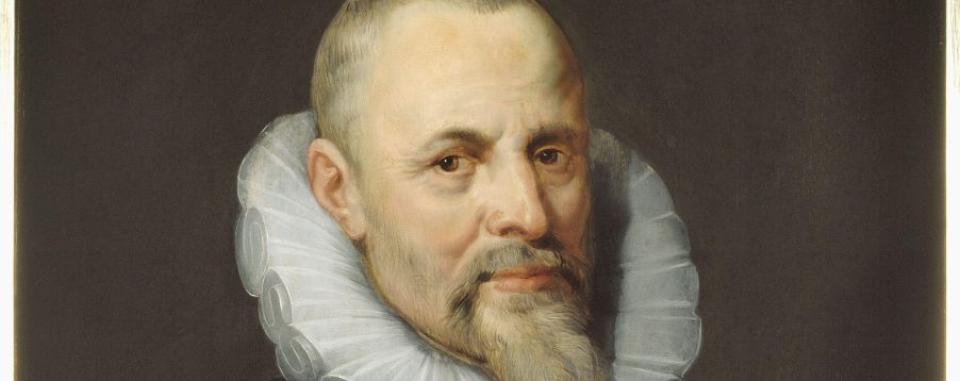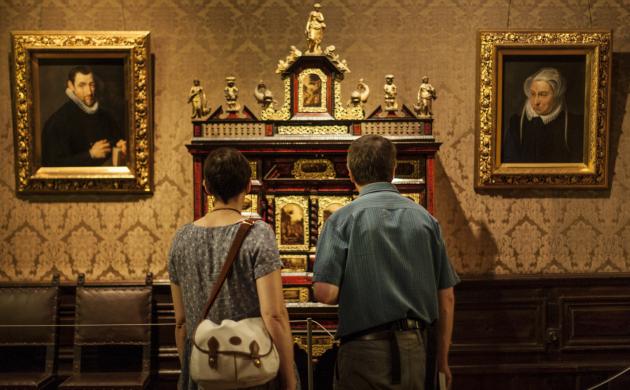After Christophe Plantin, the Moretus printing and publishing family took over at the helm of the Officina Plantiniana.
Jan Moerentorf entered Plantin’s employment at the age of fifteen, in around 1558. He worked his way up from bookshop assistant to Plantin’s right-hand man. Through self-study he mastered many languages: as well as his native Dutch, he knew French, Italian, Spanish and Latin. During Plantin’s stay in Leiden (1583-1585), he ran the Officina Plantiniana in Antwerp with his brother-in-law Franciscus Raphelengius. After Plantin’s death in 1589 he was the head of the business until 1610. Jan Moerentorf latinised his surname as ‘Moretus’.
Plantin's son-in-law and successor
Jan Moretus was already working for Plantin shortly after he started up his printing business. In 1570, he married Plantin’s second daughter, Martine. Moretus worked for nearly 32 years for Plantin, who rewarded him by leaving his printing works and bookshop to him.
Disputed will
Gillis Beys, who married Plantin’s daughter Madeleine (Magdalena) and ran his own publishing house in Paris, opposed his father-in-law’s decision. When he learned that Jan Moretus was the sole heir to the business, he petitioned for Plantin’s will to be annulled. He made a special trip to Antwerp and demanded his share of the Officina Plantiniana. Plantin’s widow and his friend and financier, the Antwerp merchant Luys Perez, mediated. In March 1590, the heirs came to an agreement: Jan Moretus and his wife got two-fifths of the business. After the death of Plantin’s widow, he would buy out the others who were awarded a share in the estate. This enabled the unity of Plantin’s publishing house to be preserved.
Plantin's privileges
As a safeguard against attempts by other publishers to get their hands on Plantin’s privileges, Jan Moretus sought a general privilege from the Council of Brabant and the Privy Council. He was granted this in 1591.
Motto
Jan Moretus’ motto was ratione recta. In a New Year’s greeting to his father-in-law on 1 January 1573, he explained that ‘Moretus’ referred to Morus, the Moorish king who followed the star of Bethlehem in search of the birthplace of Jesus. For him, this star symbolised reason (ratio).
Leading printer of the Counter-Reformation
Despite the frantic efforts of other Antwerp publishers, Jan Moretus managed to retain the ‘privileges’ or exclusive rights for the publication of lucrative liturgical works and successful Plantin editions.
Quality
For Jan Moretus, printing quality was paramount. The key factors in achieving this were the use of high-quality paper, the fonts and illustrations, and the accuracy of the printed text. Theologians such as Franciscus Lucas in Douai ensured that the content of Moretus’ Bible editions was of a high quality. They contained fewer errors than the Bibles from the presses of the Vatican printing works itself.
Collaboration with artists
In terms of illustrations, Jan Moretus initially relied on collaboration with artists such as Maarten de Vos and Peeter vander Borcht. In 1600, a unique partnership was also formed with the print studio of Theodore Galle. This son of the renowned print publisher Filips Galle married Moretus’ daughter Catherine in 1598. Together with the other artists in his studio, he produced the engravings for Moretus’ editions. Galle reworked the engravings, printed them and signed them. This partnership between the Officina Plantiniana and the print studio of Theodore Galle and his descendants lasted until almost the end of the 17th century.
Jan I Moretus' editions
640 editions in 20 years
In the twenty years that Jan I Moretus was in charge of the Officina Plantiniana, he issued 640 editions – not including government publications.
Jan I Moretus’ editions, like those of his successors, mostly related to ‘serious’ subjects, and were largely written in Latin. Half of his editions were of a religious nature. Liturgical works and prayer books accounted for a fifth of his output.
The wide distribution of these works, their fame and the later specialisation by the Officina Plantiniana in the printing of purely liturgical works led to the erroneous notion that Jan Moretus only published work of this kind.
In fact, works on history and humanism and by classical authors were also an important part of his output. For instance, the twelve-volume church history of Cardinal Caesar Baronius, the Annales ecclesiastici, was one of the major successes of the Plantin publishing house.
Justus Lipsius
Justus Lipsius was the most famous humanist of the Netherlands in the second half of the 16th century. In 1592, he returned from Leiden and became professor of history at the University of Leuven. Jan Moretus printed a total of 62 works by Justus Lipsius, becoming his main printer. In addition to his editions of the Roman authors Tacitus and Seneca and his works on all aspects of Roman history, his philosophical and political works were especially influential.
The death of Jan I Moretus
Jan I Moretus died on 22 September 1610.
In the final months before his death, he wrote optimistically that he finally felt much better now that he had thrown out all medications and prescriptions from doctors. But it was no good: he died on 22 September 1610 and was buried in the Cathedral of Our Lady.
To avoid inheritance problems, Jan I Moretus and his wife Martine stipulated in their wills that the Officina Plantiniana had to remain a single entity come what may. This brought his sons, Jan II and Balthasar I, together at the head of the Plantin publishing house.



